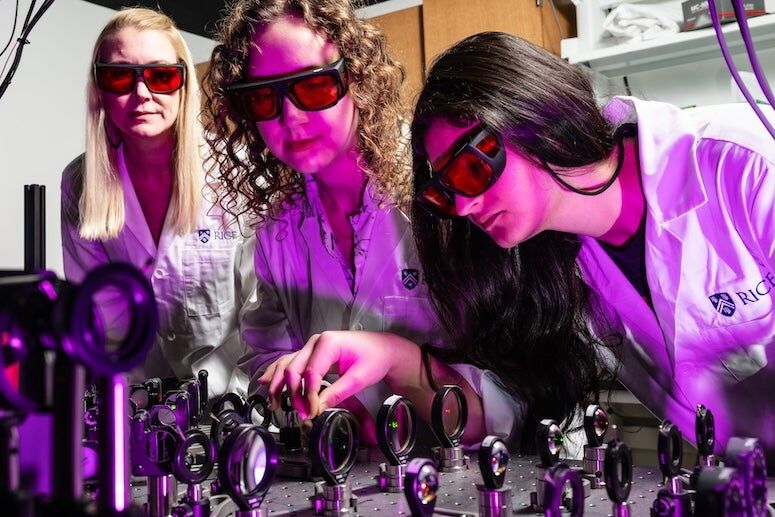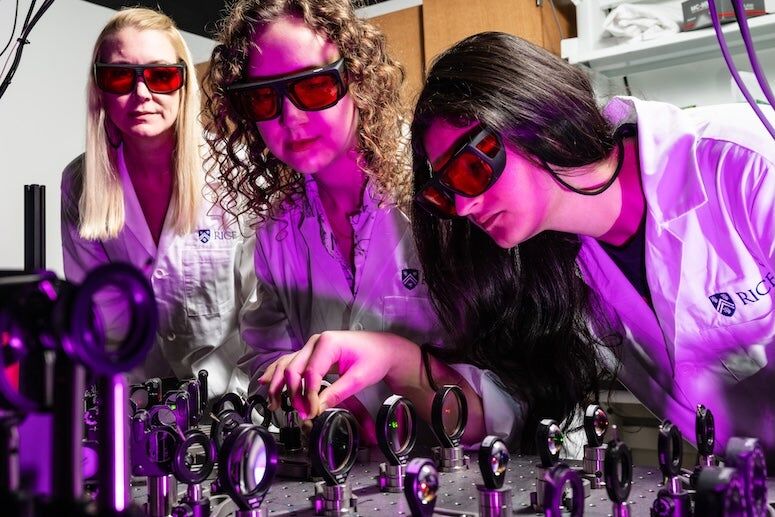“Breakthrough in the microscopic world: Scientists make groundbreaking discovery with super-resolution imaging technology, taking us inside the intricate workings of living cells. Phys.org takes you on a fascinating journey into the tiny, unseen realms that make up our living organisms, revealing the intricacies and complexities that make life so fascinating.”

Advances in Imaging Technology
Cell Imaging Limitations

In the realm of life sciences, the ability to observe the intricate workings of cells is paramount for understanding biological processes and developing targeted medical interventions. Traditional methods such as confocal microscopy have been the cornerstone of cellular imaging, but they come with significant limitations. Confocal microscopy often necessitates the use of fluorescent dyes for staining cellular components. This process, while effective, can cause photobleaching and phototoxicity, thereby altering cell behavior and compromising the longevity and accuracy of live-cell studies. These constraints have long posed challenges for researchers seeking to observe cellular dynamics in their natural state.
Novel Approach: Explainable Deep Learning with MIR-PAM
To surmount these challenges, POSTECH researchers have pioneered a novel imaging technique that combines the strengths of existing methods. This innovative approach integrates explainable deep learning with mid-infrared photoacoustic microscopy (MIR-PAM) to enhance the quality and depth of cellular imaging. By leveraging the power of artificial intelligence, this technique aims to surpass the limitations of traditional methods, providing researchers with unprecedented insights into cellular structures and functions.
Technical Breakthroughs: Dual-Phase Process
The core of this advancement lies in a dual-phase process that significantly elevates the capabilities of cellular imaging. The first phase involves Resolution Enhancement, which utilizes advanced algorithms to refine and sharpen images, enabling researchers to observe cellular structures in unprecedented detail. The second phase, Virtual Staining, utilizes AI to simulate the effects of traditional staining techniques without the need for physical dyes. This virtual staining process not only contributes to the resolution but also facilitates dye-free imaging, ensuring that cells remain unaltered and healthy during the observation period.
Practical Applications and Implications
Live Cell Imaging
The implementation of this dual-phase imaging technique opens new avenues for live cell imaging. By enabling detailed observation of cellular structures and dynamics without the adverse effects of traditional staining methods, researchers can now study cellular processes in a more natural state. This capability is particularly significant for understanding disease mechanisms, developmental biology, and the effects of pharmacological treatments on cellular behavior. For instance, in cancer research, the ability to monitor the interaction between cancer cells and their microenvironment in real-time can provide critical insights into tumor progression and potential therapeutic targets.
Multiplexed Imaging
One of the most promising applications of this technique is in multiplexed imaging. The ability to conduct label-free imaging allows for the simultaneous observation of multiple cellular components, which could revolutionize the study of complex diseases such as cancer and neurodegenerative disorders. The absence of labeling agents enables the imaging of cell processes that were previously obscured by the presence of dyes or markers. This advancement is particularly significant for research into neurological conditions, where the complex interactions between cellular components are crucial for understanding disease progression.
Therapeutic and Diagnostic Potential
The innovative imaging technique’s potential is not confined to the laboratory setting. The ability to conduct detailed, non-invasive imaging of cellular structures and dynamics has significant implications for both therapeutic and diagnostic applications. In clinical settings, this technology could be used to monitor the progression of diseases at a cellular level, providing physicians with a more precise understanding of disease states and the effectiveness of treatments. For instance, it could facilitate earlier detection of cancerous cells or alterations in brain tissue indicative of neurodegenerative diseases. This capability is poised to be a transformative tool in personalized medicine, allowing for more targeted and effective treatment strategies.
Research and Development Collaborations
Interdisciplinary Efforts
The development of this advanced imaging technique underscores the importance of collaborative efforts across various scientific disciplines. The project, spearheaded by POSTECH researchers, involved contributions from experts in biology, computer science, and engineering, among others. This interdisciplinary approach played a pivotal role in overcoming the technical challenges inherent in developing a technique that combines deep learning with mid-infrared photoacoustic microscopy. The collective expertise allowed for the creation of algorithms and imaging protocols that could effectively enhance resolution and simulate staining processes virtually, thereby addressing the limitations of conventional methods.
The success of this project is a testament to the benefits of such collaborations. By pooling resources and knowledge from diverse fields, researchers can push the boundaries of what is possible in cellular imaging and beyond. The advancements made through this project not only enhance our understanding of cellular processes but also pave the way for future innovations in the field of biophysics and bioengineering.
Future AI Applications: The Groundwork Laid by the Innovative Technique
Unionjournalism’s coverage of the advancements in super-resolution imaging technology has highlighted the groundbreaking work by POSTECH researchers in the field of life sciences. This development not only pushes the boundaries of current imaging capabilities but also lays a strong foundation for future AI applications. By integrating explainable deep learning with mid-infrared photoacoustic microscopy (MIR-PAM), the new technique significantly enhances image resolution and clarity without the need for harmful fluorescent staining.
AI Integration for Enhanced Imaging
The dual-phase process, consisting of Resolution Enhancement and Virtual Staining, paves the way for AI to play a pivotal role in imaging. The Resolution Enhancement phase leverages deep learning algorithms to amplify the resolution of MIR-PAM images, while the Virtual Staining phase simulates the effects of staining without the use of dyes, thus preserving cell integrity. This innovative approach sets the stage for AI to handle increasingly complex data, leading to more accurate and efficient imaging processes.
Institutional Partnerships: Driving Progress in Life Sciences and Imaging Technology
Collaborative Support and Interdisciplinary Efforts
The success of POSTECH researchers’ work is rooted in a robust network of institutional partnerships that foster interdisciplinary collaboration. By bringing together experts from various fields, including biologists, physicists, and computer scientists, the project exemplifies the power of collective expertise. Such collaborations are essential for driving innovation and overcoming the challenges inherent in cutting-edge research.
Examples of Collaborative Success
- Researchers from POSTECH and other institutions collaborated to develop a robust dataset for training deep learning models used in the resolution enhancement phase.
- Physicists and biologists worked in tandem to refine the MIR-PAM imaging technology, ensuring it could capture high-quality images under various conditions.
- Computer scientists provided the necessary software and computational power to process massive image datasets, facilitating real-time analysis and virtual staining.
Analysis and Future Directions
Overcoming Traditional Limitations
Traditional imaging techniques such as confocal microscopy, while effective, have limitations that hinder comprehensive live-cell studies. These include the necessity for fluorescent staining, which can cause photobleaching and phototoxicity, damaging the very cells under observation. The novel technique developed by POSTECH researchers addresses these issues by employing non-invasive imaging methods that do not compromise cellular health.
Expanding Research Possibilities
The potential of this new imaging technique to revolutionize research in life sciences is immense. By facilitating detailed and dynamic live-cell imaging without the drawbacks of traditional methods, the technique could lead to new breakthroughs in understanding cellular processes and behaviors. This could accelerate research into complex diseases such as cancer and neurodegenerative disorders, providing deeper insights into these conditions and opening avenues for innovative treatments.
Emerging Trends and Technologies
The innovative technique aligns well with current trends in imaging and life sciences, which emphasize non-invasive, high-resolution imaging with minimal impact on the subject. This development is part of a broader movement toward integrating AI and machine learning into scientific research to enhance data interpretation and analysis capabilities. The synergy between AI and imaging technology promises to drive forward the field, enabling new applications and methodologies.
Scientific Community and Impact
Community Engagement and Response
The scientific community has responded positively to the innovative imaging technique, recognizing its potential to transform research methodologies. Experts and researchers in various fields have lauded the technique for addressing long-standing limitations in cellular imaging and for its novel approach to combining AI with imaging technology. The technique’s ability to maintain cellular integrity while enhancing image quality marks a significant step forward.
Knowledge Sharing and Collaboration
Knowledge sharing and collaborative efforts are critical for the advancement of scientific research. The POSTECH project exemplifies the benefits of open collaboration, with data and methodologies made accessible to the broader scientific community. This transparency encourages further innovation and joint projects, fostering a culture of collective progress and discovery.
Societal Impact and Therapeutic Potential
The societal impact of the new imaging technique is multifaceted, with profound implications for human health and quality of life. By enabling detailed, label-free imaging of living cells, the technique can significantly enhance our understanding of cellular dynamics and complex diseases. The potential to improve diagnostic and therapeutic approaches in medicine is vast, offering hope for more effective treatments and preventive measures. The ability to observe cellular processes in real-time could also lead to breakthroughs in personalized medicine, tailoring treatments to individual patient needs with unprecedented precision.
Conclusion
As super-resolution imaging technology continues to push the boundaries of cellular research, a new era of unprecedented detail has been revealed about the intricate inner workings of living cells. According to recent findings, this innovative technology has enabled scientists to visualize cellular structures and functions at previously unimaginable scales, providing a clearer understanding of the intricate mechanisms that govern life. By harnessing the power of advanced microscopy and machine learning algorithms, researchers have been able to reconstruct detailed images of cellular structures, revealing the complex interplay of molecular mechanisms that underpin cellular function.
The significance of this breakthrough lies not only in its ability to provide a more detailed understanding of cellular biology, but also in its potential to drive innovation in fields such as medicine and biotechnology. By gaining a deeper understanding of cellular function, researchers may be able to develop new treatments for diseases, improve our understanding of cellular aging, and even engineer new biological systems for industrial applications. As the field continues to evolve, it is likely that super-resolution imaging technology will play a major role in driving these advances.
As we gaze into the microscopic realm, we are reminded that the intricate beauty of living cells holds the key to unlocking new possibilities for human health and well-being. As we continue to push the boundaries of this technology, we may yet uncover new secrets about the fundamental nature of life itself. The question now is not what we will discover next, but how we will harness that knowledge to create a brighter future for all.
